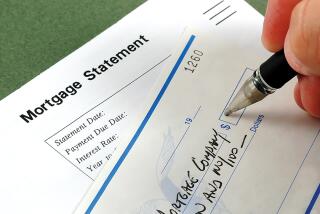5- to 7-Year Mortgages Gaining in Popularity
A growing number of borrowers are rejecting standard, 30-year mortgages and opting for shorter-term loans to build equity faster and save thousands of dollars in finance charges.
Fifteen-year loans and other types of âquick-payâ mortgages accounted for about 28% of all lending activity in September, according to the Federal National Mortgage Assn. Thatâs up from 19% a year earlier.
A 15-year pay-back schedule has traditionally been the most-popular alternate choice for borrowers who donât want a 30-year term.
Fifteen-year loans offer several advantages over their 30-year cousins: Their shorter term, coupled with the fact that rates on 15-year loans are usually about one-quarter of a point lower, cuts a borrowerâs overall financing costs by more than 50%.
Equally important, the borrower will own the house free and clear in half the time it takes to pay off a 30-year loan.
âWeâre seeing a lot of people in their 40s take out shorter-term loans because they want to save on their interest charges and have their house paid off before they retire,â said Gene Eisman, a Fannie Mae spokesman.
âA lot of recent buyers, and homeowners who are refinancing, are also taking them out so theyâll be done with their mortgage payments by the time their kids are finally ready to start college.â
Perhaps the biggest drawback to 15-year loans is that theyâre a little harder to get than those amortized over 30 years. Thatâs because the higher monthly payments required by the short-term pay-back schedule means you have to make more money to qualify for the loan.
Still, donât make the mistake of thinking that payments on a 15-year loan are twice as large as those on a 30-year mortgage: Theyâre usually only 20% to 30% higher, because more of each monthly payment goes toward principal instead of interest.
Thatâs not a bad exchange for paying your loan off twice as fast, but it makes 15-year loans unattractive to first-time buyers who are on a tight budget.
Lenders say that borrowers who want to build equity even faster are opting for 10-year repayment schedules, while those who canât quite handle the relatively high monthly payments that 15-year loans entail are choosing 20-year terms.
Threatening to replace 15-year loans as the No. 2 choice among borrowers are five-year and seven-year âballoonâ mortgages.
Balloon loans only became widely available in the last year or two. They got their nickname because the final payment on the loan is several times larger than the previous monthly payments--in other words, the last check you write âballoons.â
The two most common types of balloons are the â30-due-in-5â and the â30-due-in-7.â
If you took out a 30/5 for $100,000, the entire outstanding balance of your loan would be due at the end of five years. However, your monthly payments would be based on a 30-year pay-back schedule, which would keep your monthly payments relatively low and deductions for mortgage-interest payments high.
More important, the rate on the 30/5 would be about a half-point lower than the rate youâd get if you took out a standard 30-year loan. Thatâs because the lender knows that the five-year term reduces the risk that it will lose money if rates soar in the future.
âA lot of our first-time buyers are choosing balloons because the discount they get on their interest rate helps to keep their monthly payments to a minimum,â said Phil Lichterman, a mortgage broker at ERA Unique Financial Services in Toluca Lake.
The primary problem with many types of balloon loans is that all the money must be repaid in a lump sum within five or seven years. That means that youâll probably have to sell your home or pay lots of money to refinance when the loan comes due.
If the thought of refinancing or selling in a relatively short period of time scares you, you might want to find a lender that offers a balloon with an âextensionâ option.
You exercise your option if the term of the loan expires and you want to stay put. The lender will simply adjust your rate to match those being offered at the time, saving you the hassle and expense of moving or refinancing.
The extension option âis sort of like a âsafety valveâ for borrowers,â Lichterman said. âIt prevents them from being forced out when the loan comes due.â
Actually, Lichterman said, the five-year and seven-year pay-back deadlines donât worry too many borrowers because most plan to trade up into a larger home before the term of their loan expires.
Many experts say the shift toward shorter-term mortgages could be here to stay.
âConsumers have gotten a lot smarter over the years, and they donât want to pay the kind of long-term finance charges that 30-year loans entail,â said David W. Stewart, a marketing professor at the USC School of Business.
âMaybe more important, there are some demographic trends at work here,â he added. âThe baby boomers are buying homes a lot later than their parents did.
âIf you buy your first home at the age of 40, you sure donât want to be paying on a 30-year loan when youâre in your 70s,â Stewart said. âInstead, youâll want to get out from under that mortgage payment as soon as possible so you can relax and enjoy life more.â
More to Read
Inside the business of entertainment
The Wide Shot brings you news, analysis and insights on everything from streaming wars to production â and what it all means for the future.
You may occasionally receive promotional content from the Los Angeles Times.










